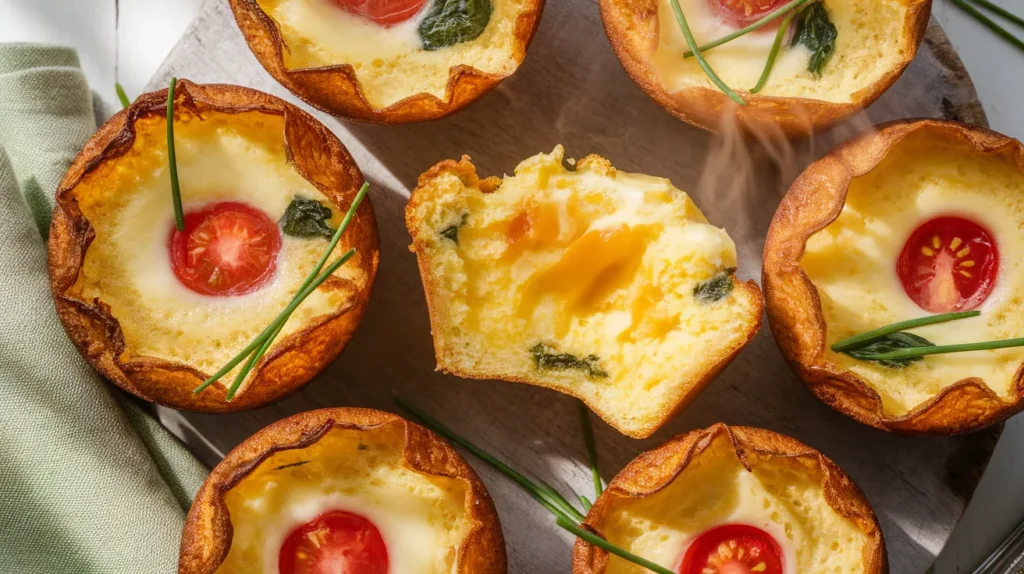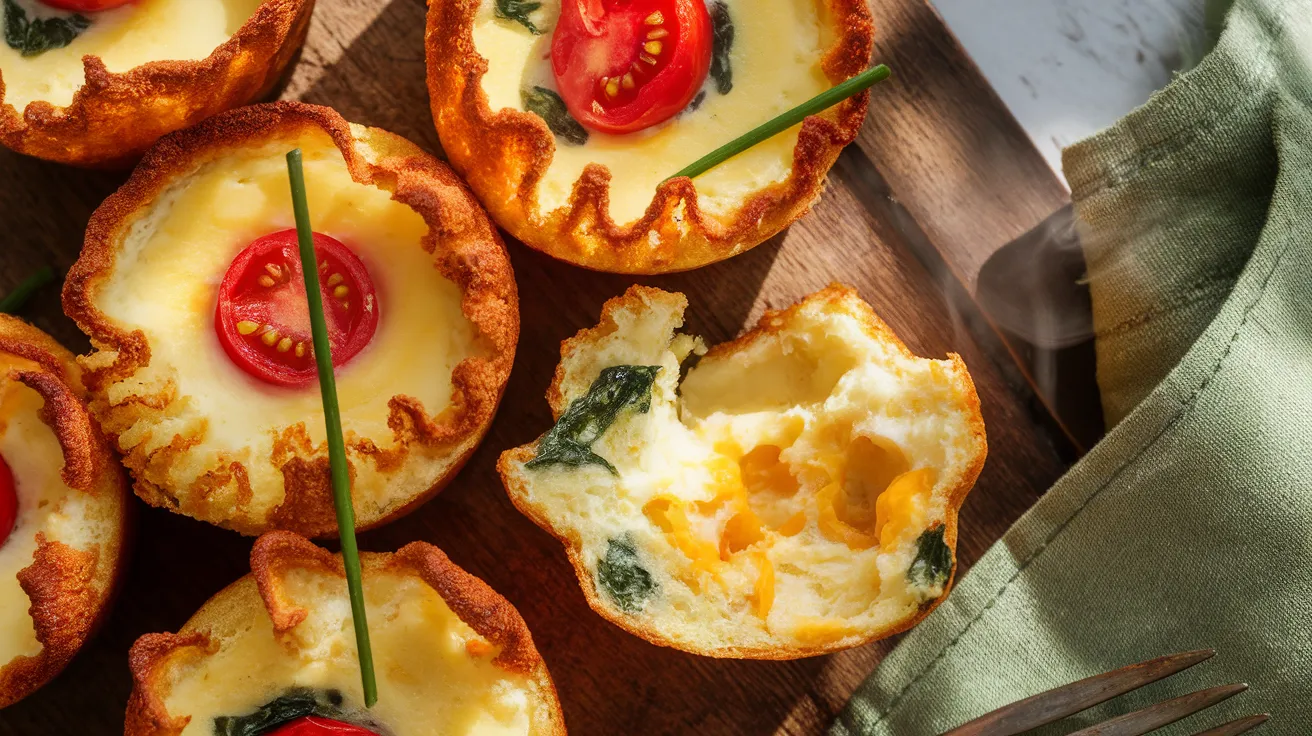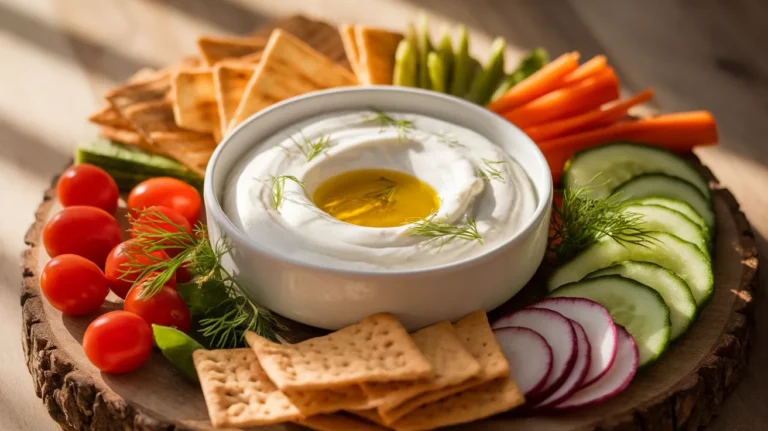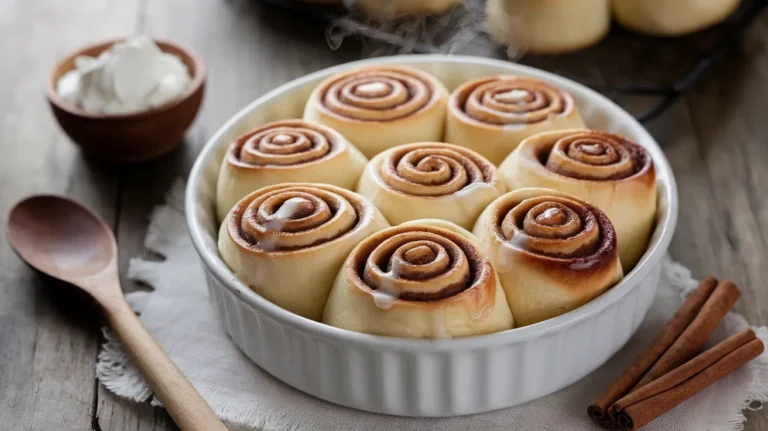These pillowy ricotta egg muffins transform your morning routine with their cloud-like texture and customizable flavors. Perfect for meal prep, these protein-packed ricotta egg muffins stay moist for days and reheat beautifully, making breakfast a breeze all week long.
SERVES: 4 | PREP: 15 MIN | COOK: 22 MIN | TOTAL: 37 MIN
Ingredients
Egg Base:
| Ingredient | Amount |
|---|---|
| Large eggs | 6 whole |
| Whole milk ricotta cheese | 1 cup (8 oz) |
| Heavy cream | ¼ cup |
| Kosher salt | ½ teaspoon |
| Black pepper | ¼ teaspoon |
| Garlic powder | ¼ teaspoon |
Mix-Ins & Toppings:
| Ingredient | Amount |
|---|---|
| Baby spinach, chopped | 1 cup packed |
| Cherry tomatoes, halved | ½ cup |
| Sharp cheddar cheese, shredded | ½ cup |
| Fresh chives, minced | 2 tablespoons |
| Parmesan cheese, grated | ¼ cup |
Step-by-Step Instructions
Phase 1: Prep Work (5 minutes)
Step 1: Position your oven rack in the center and preheat to 375°F. This specific temperature ensures the muffins puff up without browning too quickly on top. A center rack provides even heat circulation for uniform cooking.
Step 2: Generously coat a 12-cup muffin tin with cooking spray, making sure to get the sides too. The ricotta makes these muffins slightly sticky, so thorough greasing prevents frustrating sticking. You’ll only fill 8 cups, but having a 12-cup tin gives you options for placement.
Step 3: Line your workspace with paper towels and lay out the baby spinach. Pat it completely dry with more paper towels. Excess moisture is your enemy here – wet spinach creates watery pockets in your muffins that ruin the fluffy texture.
Phase 2: Building Your Batter (6 minutes)
Step 4: Crack all 6 eggs into a large mixing bowl. Look for any shell pieces and remove them immediately. Room temperature eggs blend more smoothly with ricotta, but cold eggs work fine – just whisk a bit longer.
Step 5: Add the ricotta cheese directly to the eggs. Using whole milk ricotta is crucial because low-fat versions release water during baking, making your muffins dense instead of fluffy. The fat content keeps everything tender.
Step 6: Pour in the heavy cream, then add salt, pepper, and garlic powder. The cream adds richness and helps create that signature creamy texture. Don’t skip the garlic powder – it adds depth without overpowering the delicate ricotta flavor.
Step 7: Whisk vigorously for 60-90 seconds until completely smooth and slightly frothy. You want zero ricotta lumps remaining. The mixture should look like a thick, creamy custard. Those tiny air bubbles you’re creating help make the muffins light.
Step 8: Fold in the dried spinach using a rubber spatula. Use gentle strokes to keep the air you just whisked in. The spinach should be evenly distributed but not bruised or broken down.
Phase 3: Assembly (4 minutes)
Step 9: Using a ¼ cup measuring cup, scoop the egg mixture into 8 muffin cups, filling each about ¾ full. This specific amount allows room for the muffins to puff up without overflowing. Wipe any drips from the tin edges – they’ll burn and smell.
Step 10: Drop 3-4 cherry tomato halves into each cup, pushing them slightly into the mixture. The tomatoes release moisture as they cook, creating little pockets of juicy sweetness that contrast beautifully with the creamy eggs.
Step 11: Sprinkle 1 tablespoon of shredded cheddar into each muffin. Don’t stir it in – letting it sit on top creates those golden, crispy cheese spots everyone loves. The cheese also helps hold the muffin together.
Step 12: Finish with a light dusting of Parmesan and a few chives on each muffin. The Parmesan creates a slightly crispy top while the chives add color and a mild onion flavor.
Phase 4: Baking to Perfection (22 minutes)
Step 13: Carefully place the muffin tin on the center oven rack. Set a timer for 18 minutes. Avoid opening the oven door during this time – temperature fluctuations can cause the muffins to deflate or cook unevenly.
Step 14: At 18 minutes, check for doneness. The tops should be golden brown and spring back when gently pressed. Insert a toothpick into the center – it should come out with just a few moist crumbs, not wet batter.
Step 15: If they need more time, bake in 2-minute increments, checking after each interval. Overbaking makes them rubbery, so watch carefully. The edges will pull slightly away from the tin when they’re perfect.
Step 16: Remove from the oven and let cool in the tin for exactly 3 minutes. This brief rest lets the structure set without continuing to cook from residual heat. The muffins will deflate slightly – that’s normal and expected.
Step 17: Run a thin knife around each muffin’s edge to loosen it. Use a gentle sawing motion rather than forcing it. If you greased well, they should release easily with a slight twist.
Step 18: Transfer to a wire cooling rack. Let them cool for 5 minutes before serving. This prevents the bottoms from getting soggy from trapped steam. They’re delicious warm but also amazing at room temperature.
Chef’s Notes
The Ricotta Secret: Whole milk ricotta egg muffins rise higher and taste richer than versions made with part-skim. The extra fat creates steam pockets during baking that make them incredibly fluffy.
Drainage Matters: Always squeeze excess liquid from vegetables before adding them. Mushrooms, zucchini, and bell peppers all release moisture that can turn your muffins watery.
Temperature Precision: An oven thermometer is worth the investment. Many ovens run 25°F hotter or cooler than the dial shows, which drastically affects these delicate muffins.
The Puff Factor: Don’t panic when your ricotta egg muffins deflate slightly after removing them from the oven. This natural settling actually creates the perfect tender texture you want.
Nutrition Information (Per 2 Muffins)
Calories: 285
Protein: 18g
Carbohydrates: 6g
Fat: 21g
Fiber: 1g
Sugar: 3g
Creative Variations
Mediterranean Magic: Replace spinach with sun-dried tomatoes and swap cheddar for crumbled feta. Add kalamata olives and dried oregano for authentic Greek flavors. This variation pairs perfectly with my ricotta egg casserole for a complete brunch spread.
Southwestern Fiesta: Mix in black beans, corn, diced jalapeños, and pepper jack cheese. Top with fresh cilantro and serve with salsa for dipping.
Italian Garden: Use roasted red peppers, fresh basil, and mozzarella cheese. Finish with a drizzle of balsamic glaze after baking for restaurant-quality results.
Mushroom Lover’s Dream: Sauté cremini mushrooms with thyme, then fold into the batter with gruyère cheese. The earthy flavors complement the creamy ricotta beautifully, similar to the protein-packed combinations in my ricotta egg salad.
Storage & Reheating
Refrigerator Storage: Place cooled muffins in an airtight container with parchment paper between layers. They’ll stay fresh for 5 days. The ricotta keeps them moist longer than regular egg muffins.
Freezer Instructions: Wrap individual muffins in plastic wrap, then place in a freezer bag. Freeze for up to 3 months. Label with the date and ingredients for easy identification.
Reheating Methods: Microwave for 30-45 seconds on 70% power to prevent rubbery texture. Or reheat in a 300°F oven for 8-10 minutes for crispy edges. Add a sprinkle of water before reheating to restore moisture.
Make-Ahead Strategy: Prep the egg mixture the night before and store in the fridge. In the morning, give it a quick whisk, add fresh vegetables, and bake. You’ll have hot muffins in under 25 minutes.

Troubleshooting Common Issues
Problem 1: Muffins Are Watery
Solution: Your vegetables weren’t dry enough. Always pat leafy greens completely dry and drain watery vegetables like zucchini on paper towels for 10 minutes before adding. Squeeze tomatoes gently to remove excess seeds and juice.
Problem 2: Muffins Stuck to Tin
Solution: You didn’t grease thoroughly enough. Use cooking spray AND a paper towel to spread it around, ensuring complete coverage of sides and bottom. Consider using silicone muffin cups as a foolproof alternative.
Problem 3: Rubbery Texture
Solution: You overcooked them. These ricotta egg muffins continue cooking from residual heat after removing from oven. Pull them when they’re just set but still slightly jiggly in the center – they’ll firm up perfectly as they cool.
Problem 4: Muffins Deflated Too Much
Solution: Your oven temperature was too high, causing rapid rising and collapse. Verify actual temperature with an oven thermometer. Also ensure you’re not opening the oven door during the first 18 minutes of baking.
Problem 5: Bland Flavor
Solution: Don’t be shy with seasonings. Eggs need more salt than you think. Add ¾ teaspoon salt instead of ½, and consider adding hot sauce, mustard powder, or fresh herbs to boost flavor complexity.
Equipment Essentials
- 12-cup standard muffin tin (metal conducts heat better than silicone)
- Large mixing bowl (at least 2-quart capacity for vigorous whisking)
- Wire whisk (balloon style incorporates more air than flat whisks)
- Rubber spatula (for gentle folding without deflating mixture)
- ¼ cup measuring cup (ensures uniform portions)
- Sharp knife (for releasing muffins without tearing)
- Wire cooling rack (prevents soggy bottoms from trapped steam)
Shopping List
Dairy Section:
- Whole milk ricotta cheese (8 oz)
- Heavy cream (¼ cup)
- Sharp cheddar cheese (4 oz)
- Parmesan cheese (2 oz)
- Large eggs (6 count)
Produce Section:
- Baby spinach (1 package)
- Cherry tomatoes (1 pint)
- Fresh chives (1 bunch)
Pantry Staples:
- Kosher salt
- Black pepper
- Garlic powder
- Cooking spray
Success Secrets
1. Room Temperature Ingredients: Let eggs and ricotta sit at room temperature for 30 minutes before mixing. This creates a smoother batter that bakes more evenly, resulting in fluffier muffins.
2. The Whisking Technique: Whisk in a figure-eight pattern for 90 seconds to incorporate maximum air. This simple motion creates those perfect air pockets that make ricotta egg muffins rise beautifully.
3. Strategic Filling: Never fill muffin cups more than ¾ full. These expand significantly during baking, and overfilling leads to mushroom-topped muffins that stick to neighboring cups.
4. The Toothpick Test: Insert the toothpick at a slight angle rather than straight down. This tests more of the muffin’s interior and gives you a better read on doneness.
5. Cooling Patience: Resist eating immediately – those 8 minutes of cooling time allows the internal structure to set properly. Hot-from-the-oven muffins taste great but can be mushy and fall apart. Slightly cooled muffins have the perfect tender-firm texture.




